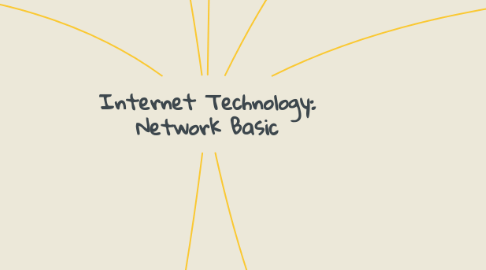
1. Advantages of Using A Network
1.1. Facilitating communications
1.2. Sharing software
1.3. Transferring funds
1.4. Facilitating communications
1.5. Sharing hardware
1.6. Sharing data and information
2. Disadvantages of Using Network
2.1. Viruses
2.2. Network Failure
2.3. Slow service
2.4. Cost
2.5. Expert support required
3. Network Topology
3.1. Ring
3.1.1. Advantages
3.1.1.1. Simple transmission of data
3.1.1.2. Cable faults easily located
3.1.2. Disadvantages
3.1.2.1. Failure in any cable break the loop
3.1.2.2. Data packest must pass through every computer thus it becomes slower
3.1.2.3. Difficult to install
3.2. Bus
3.2.1. Advantages
3.2.1.1. Devices can be attached/ detached without disturbing the network
3.2.1.2. Failure of one device does not affect the rest
3.2.2. Diisadvantages
3.2.2.1. A break in the cable prevent all systems from accessing the network
3.2.2.2. Difficult to identify problem if the entire network shutdown
3.3. Star
3.3.1. Advantages
3.3.1.1. If one device fails, only that device is connected
3.3.1.2. Devices can be added/removed with little disruption
3.3.1.3. Easy to troubleshoot and isolate problem
3.3.2. Disadvantages
3.3.2.1. if hub/switch fails Entire network inoperable
3.3.2.2. Requires cable the most
3.3.2.3. More expensice (cost of hub)
4. Communication Device
4.1. Sending device
4.1.1. Communication device
4.1.1.1. Transmission media
4.1.1.1.1. Communication System
5. Types of Transmission Media
5.1. Wired Transmission media
5.1.1. Fibre-optic cable
5.1.2. Cable television
5.1.3. Telephone networks
5.2. Wireless Transmission Media
5.2.1. Cellular radio
5.2.2. Satellite
5.2.3. Broadcast radio
5.2.4. Microwaves
5.2.5. Bluetooth
5.2.6. Infrared
6. Network Architecture
6.1. Peer-to-peer
6.1.1. Characteristics
6.1.1.1. Easy to install
6.1.1.2. Equal responsibilities
6.2. Client-Server
6.2.1. Characteristics
6.2.1.1. Network professionals needed
6.2.1.2. High responsibilities for servers
7. Network Classification
7.1. LAN
7.1.1. Area: Limited
7.1.1.1. Computer Laboratory
7.1.1.2. Campus
7.1.2. Advantages
7.1.2.1. Easy to share devices
7.1.2.2. Easy to share data
7.1.3. Disadvantages
7.1.3.1. Power
7.1.3.1.1. A good LAN should be ON all time
7.1.3.2. Can reduce speed
7.1.3.3. Area covered is limited
7.2. MAN
7.2.1. Area: Metropolitan
7.2.1.1. City
7.2.1.2. Town
7.2.2. Advantages
7.2.2.1. Efficiency and shared access
7.2.2.2. Residents have equal ability to go online
7.3. WAN
7.3.1. Area: Large geographical are
7.3.1.1. Country
7.3.1.2. World
7.3.2. Advantages
7.3.2.1. Increase efficiency
7.3.2.2. Ease communication
7.3.2.3. Lowered costs
7.3.3. Disadvantages
7.3.3.1. Security problems
7.3.3.2. Training costs
7.3.3.3. Maintenance porblems
